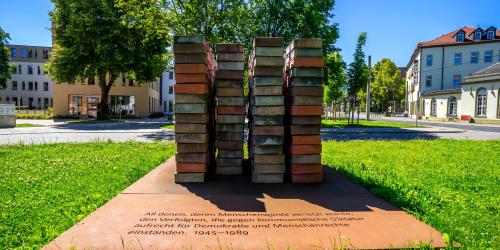
Lecture on June 17, 1953 in Jena
The "People's Uprising" 70 years ago is the topic on Monday, June 26, at 6 p.m. in the town hall
How the uprising of Berlin construction workers against the social consequences of the "accelerated construction of socialism" decided by the Second Party Conference of the SED in 1952 could spread to a mass uprising in 700 cities and municipalities within a few hours - this is the question that the Jena journalist Frank Döbert will explore in his lecture on Monday, June 26. The GDR plunged into a deep political crisis. What were the reasons that prompted 20,000 Jena residents to take part in the protest, which subsequently led to the storming of several buildings, the deployment of Soviet tanks and a massive wave of arrests? With reference to numerous photographs and archive documents as well as eyewitness accounts, only some of which have previously been included in analyses of June 17, 1953, the events can be described in more detail.
Prehistory of June 17, 1953 in Jena
As in other cities in the GDR, the situation in Jena was extremely tense in the early summer of that year: more and more people were fleeing the republic as a result of a persistently difficult supply situation for the population, accompanied by high prices. The SED tried to calm the situation with draconian punishments for even minor economic offenses. However, the arrest of 15 senior employees of Carl Zeiss by the State Security in March 1953 under the pretext of betraying secrets and espionage for the benefit of Zeiss Oberkochen, as well as the action taken against pupils and students who belonged to the Young Congregations of the Protestant Church in Jena, which had been declared an "enemy organization", did the rest to bring the "barrel to overflowing". As a result, the SED, People's Police and MfS found themselves unable to contribute to a de-escalation of the events with a coordinated strategy of action. The wave of arrests that began on the same day only increased the will to resist. The result was another call for a strike at Zeiss in July 1953, but this time it was to be categorically suppressed with a massively expanded apparatus of repression.
GDR propaganda labeled the unrest declared by the "West" as a "popular uprising" as a "fascist coup attempt". This had been initiated by the RIAS and American secret services. Declassified files from the CIA and other services now allow largely true-to-life information from this side on one of the most formative days in the GDR during the Cold War.
Lecture: "June 17, 1953 in Jena"
Date: Monday, June 26, 2023, 6 p.m.
Location: Town Hall
Admission is free.
